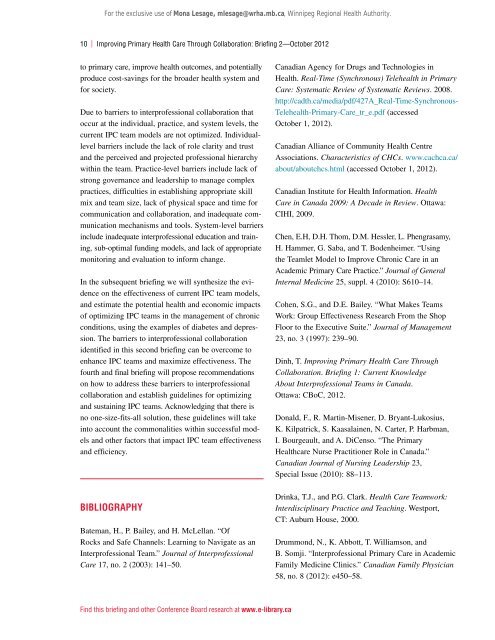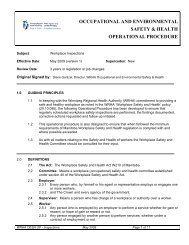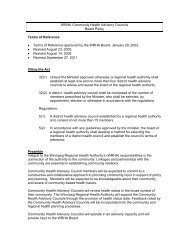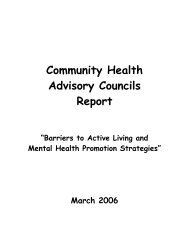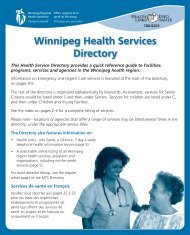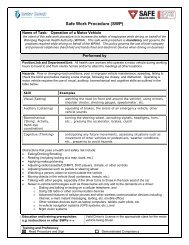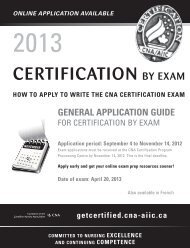Improving Primary Health Care Through Collaboration: Briefing 2 ...
Improving Primary Health Care Through Collaboration: Briefing 2 ...
Improving Primary Health Care Through Collaboration: Briefing 2 ...
- No tags were found...
You also want an ePaper? Increase the reach of your titles
YUMPU automatically turns print PDFs into web optimized ePapers that Google loves.
For the exclusive use of Mona Lesage, mlesage@wrha.mb.ca, Winnipeg Regional <strong>Health</strong> Authority.10 | <strong>Improving</strong> <strong>Primary</strong> <strong>Health</strong> <strong>Care</strong> <strong>Through</strong> <strong>Collaboration</strong>: <strong>Briefing</strong> 2—October 2012to primary care, improve health outcomes, and potentiallyproduce cost-savings for the broader health system andfor society.Due to barriers to interprofessional collaboration thatoccur at the individual, practice, and system levels, thecurrent IPC team models are not optimized. Individuallevelbarriers include the lack of role clarity and trustand the perceived and projected professional hierarchywithin the team. Practice-level barriers include lack ofstrong governance and leadership to manage complexpractices, difficulties in establishing appropriate skillmix and team size, lack of physical space and time forcommunication and collaboration, and inadequate communicationmechanisms and tools. System-level barriersinclude inadequate interprofessional education and training,sub-optimal funding models, and lack of appropriatemonitoring and evaluation to inform change.In the subsequent briefing we will synthesize the evidenceon the effectiveness of current IPC team models,and estimate the potential health and economic impactsof optimizing IPC teams in the management of chronicconditions, using the examples of diabetes and depression.The barriers to interprofessional collaborationidentified in this second briefing can be overcome toenhance IPC teams and maximize effectiveness. Thefourth and final briefing will propose recommendationson how to address these barriers to interprofessionalcollaboration and establish guidelines for optimizingand sustaining IPC teams. Acknowledging that there isno one-size-fits-all solution, these guidelines will takeinto account the commonalities within successful modelsand other factors that impact IPC team effectivenessand efficiency.BibliographyBateman, H., P. Bailey, and H. McLellan. “OfRocks and Safe Channels: Learning to Navigate as anInterprofessional Team.” Journal of Interprofessional<strong>Care</strong> 17, no. 2 (2003): 141–50.Canadian Agency for Drugs and Technologies in<strong>Health</strong>. Real-Time (Synchronous) Telehealth in <strong>Primary</strong><strong>Care</strong>: Systematic Review of Systematic Reviews. 2008.http://cadth.ca/media/pdf/427A_Real-Time-Synchronous-Telehealth-<strong>Primary</strong>-<strong>Care</strong>_tr_e.pdf (accessedOctober 1, 2012).Canadian Alliance of Community <strong>Health</strong> CentreAssociations. Characteristics of CHCs. www.cachca.ca/about/aboutchcs.html (accessed October 1, 2012).Canadian Institute for <strong>Health</strong> Information. <strong>Health</strong><strong>Care</strong> in Canada 2009: A Decade in Review. Ottawa:CIHI, 2009.Chen, E.H, D.H. Thom, D.M. Hessler, L. Phengrasamy,H. Hammer, G. Saba, and T. Bodenheimer. “Usingthe Teamlet Model to Improve Chronic <strong>Care</strong> in anAcademic <strong>Primary</strong> <strong>Care</strong> Practice.” Journal of GeneralInternal Medicine 25, suppl. 4 (2010): S610–14.Cohen, S.G., and D.E. Bailey. “What Makes TeamsWork: Group Effectiveness Research From the ShopFloor to the Executive Suite.” Journal of Management23, no. 3 (1997): 239–90.Dinh, T. <strong>Improving</strong> <strong>Primary</strong> <strong>Health</strong> <strong>Care</strong> <strong>Through</strong><strong>Collaboration</strong>. <strong>Briefing</strong> 1: Current KnowledgeAbout Interprofessional Teams in Canada.Ottawa: CBoC, 2012.Donald, F., R. Martin-Misener, D. Bryant-Lukosius,K. Kilpatrick, S. Kaasalainen, N. Carter, P. Harbman,I. Bourgeault, and A. DiCenso. “The <strong>Primary</strong><strong>Health</strong>care Nurse Practitioner Role in Canada.”Canadian Journal of Nursing Leadership 23,Special Issue (2010): 88–113.Drinka, T.J., and P.G. Clark. <strong>Health</strong> <strong>Care</strong> Teamwork:Interdisciplinary Practice and Teaching. Westport,CT: Auburn House, 2000.Drummond, N., K. Abbott, T. Williamson, andB. Somji. “Interprofessional <strong>Primary</strong> <strong>Care</strong> in AcademicFamily Medicine Clinics.” Canadian Family Physician58, no. 8 (2012): e450–58.Find this briefing and other Conference Board research at www.e-library.ca


